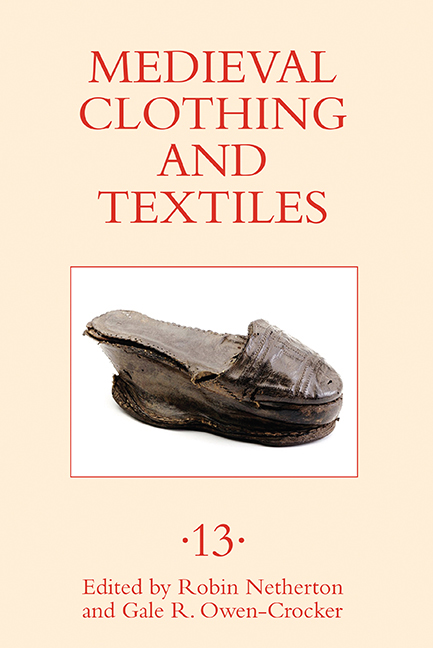Book contents
- Frontmatter
- Contents
- Illustrations
- Tables
- Contributors
- Preface
- 1 The Significance of Dress in the Bayeux Tapestry
- 2 How Long Is a Launce? Units of Measure for Cloth in Late Medieval Britain
- 3 Robes, Turbans, and Beards: “Ethnic Passing” in Decameron 10.9
- 4 Calciamentum: Footwear in Late Medieval Lucca
- 5 “Bene in ordene et bene ornata“: Eleonora d’Aragona’s Description of Her Suite of Rooms in a Roman Palace of the Late Fifteenth Century
- 6 The Lübeck Wappenröcke: Distinctive Style in Fifteenth-Century German Fabric Armor
- Recent Books of Interest
- Contents of Previous Volumes
6 - The Lübeck Wappenröcke: Distinctive Style in Fifteenth-Century German Fabric Armor
Published online by Cambridge University Press: 12 August 2020
- Frontmatter
- Contents
- Illustrations
- Tables
- Contributors
- Preface
- 1 The Significance of Dress in the Bayeux Tapestry
- 2 How Long Is a Launce? Units of Measure for Cloth in Late Medieval Britain
- 3 Robes, Turbans, and Beards: “Ethnic Passing” in Decameron 10.9
- 4 Calciamentum: Footwear in Late Medieval Lucca
- 5 “Bene in ordene et bene ornata“: Eleonora d’Aragona’s Description of Her Suite of Rooms in a Roman Palace of the Late Fifteenth Century
- 6 The Lübeck Wappenröcke: Distinctive Style in Fifteenth-Century German Fabric Armor
- Recent Books of Interest
- Contents of Previous Volumes
Summary
In Lübeck, Germany, there are two garments, nearly identical, that represent a unique style in armor fashion found only in Germany for about fifty years in the middle of the fifteenth century. They are thickly padded, with radiating lines of quilting on the upper and lower back and a painted surface that highlights the quilting. They also have a distinctive skirting that gives the impression of fur, but is, in reality, made using a curious fabric treatment. The garments have extensive damage to the front panels as well as the skirting, but despite this, they attest to a visually striking style that can be immediately identified in contemporary statues and paintings (figs. 6.1 to 6.4).
The story of these garments, held separately in the Museum Holstentor and the St. Annen Museum before their move in late 2014 to the new Europäisches Hansemuseum in Lübeck, exemplifies the compelling lore that can be attached to historical items, rightly or wrongly, and how it affects our understanding of these artifacts. With this paper I will document my findings from my examination of one of the so-called Lübeck wappenröcke. In particular, I will detail the materials used, the likely methods of construction, and the results of a chemical analysis of the black paint used to decorate the back of the garment. I hope to also shed some light upon the possible reasons for peculiarities found in the tailoring of these garments. As with any such study, more questions were raised by my examination that will need to be answered with future research.
FASHIONABLE FABRIC ARMOR
There is no generally accepted term that describes and applies to garments in the style of the Lübeck garments, but the museum's catalog refers to them alternately as wappenrock or Vasa-rock (the latter literally “Vasa's jacket,” after their connection with Sweden's King Gustav Vasa I, about which more below). Wappenrock (pronounced VAF-en-rok) translates most often as “surcoat” in the medieval sense, and as a military uniform coat in a modern sense. While it is true that this garment was intended to be worn over some pieces of armor, it is not so much a surcoat as it is true fabric armor, designed to protect the body from weapon strikes.
- Type
- Chapter
- Information
- Medieval Clothing and Textiles 13 , pp. 121 - 152Publisher: Boydell & BrewerPrint publication year: 2017
- 1
- Cited by

